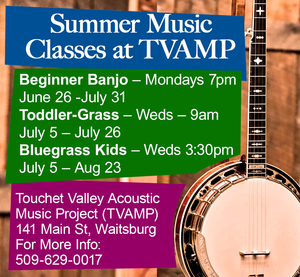Dayton-Waitsburg Combine committee discusses future of the program
Public surveys, meetings with community members reveal stronger support than expected.
December 19, 2019

Beka Compton
The Dayton-Waitsburg Athletic Combine advisory board reviews the results of the public survey last week. The meeting was well attended by coaches, athletes, and parents.
WAITSBURG-The Dayton-Waitsburg Athletic Combine Advisory Committee met December 11, at the Preston Hall Middle School in Waitsburg. The Board reviewed the results of the recent community-wide survey, discussed the data, and made a recommendation to both the Waitsburg and Dayton School Boards based on the information received and the feedback given by athletes, parents and coaches. Roughly 20 parents/coaches were in attendance, and roughly 20 student athletes were at the meeting.
Advisory board members present were Charlie Barron, Steve Martin, Johnny Watts, Doug Johnson, Katie Leid, Paula Moisio, Kristina Brown, Mark Pickel, Stephanie Wooderchak, and Jason Mings.
The Dayton Waitsburg Athletic Combine is close to the end of the original two-year commitment. The WIAA classification deadline is January 26, 2020, and whether the combine continues or not will affect the school classification, as well as coaching staff, schedules, transportation, uniforms, and other items.

On November 20, a survey asking for feedback about the combine was released to the students and community members of both Dayton and Waitsburg. The survey asked for feedback on problems experienced, whether the combine had been a positive experience, and provided community members with a comment section. The results of the survey surprised the advisory board members in a very good way.
Overall, the results of the survey were positive. 66.8 percent of survey participants said yes to continuing the DW Athletic Combine. Looking at the combined data, only 37.4 percent of survey participants said that they wanted to continue the Combine on a sport by sport basis, and only 23 percent of survey takers thought that the Combine should be a high school only program, making it clear that the majority of parents and students wanted the Combine to continue, and to start at the middle school level.
In regards to frustrations with the Combine, the data gathered from the survey responses showed that the biggest challenge was transportation, with 32.7 percent of the combined data selecting this option. The next challenge, which garnered 25.8 percent of the combined responses was 'none,' meaning that the survey takers felt there either weren't challenges, or that the challenges weren't big enough to impact the answer. There were no issues that had overwhelmingly strong responses; all of the answers were fairly close to each other.

Most of the students responded that the Combine was a positive experience for them. 38.6 percent of D-W athletes said that the Combine encouraged them to participate in sports, and 46.3 percent said that the Combine was a positive experience. 22.1 percents of students said that the Combine was not a positive experience, but 31.6 percent answered 'not applicable' when asked if it was a positive experience. The survey was open to students, not just athletes. 64.6 percent of students who took the survey said that they would participate in the Dayton Waitsburg Combine in the future.
The committee acknowledged that there are some areas that will need improvement, and that if the Combine were to move forward, they would need to address the issues that are in their control. A combined student and coaches handbook was one of the items brought up that would need to be created. Dayton and Waitsburg schools have slightly different GPA systems, and the committee acknowledged that common eligibility rules would need to be established. The other issue of concern was a shared mascot, name, and colors. Deciding on the mascot and colors would allow uniform purchases, as well as spirit building moving forward.
The survey evidence was pretty clear that most of the students and parents wanted the D-W Combine to continue. Once the board members had discussed the findings, they opened up the meeting for public comment. Each speaker was allowed two minutes to comment.
Roy Ramirez, the High School head boys basketball coach, encouraged the board to make a decision sooner, rather than later, so that the schools can have everything ready for WIAA classification, and so that coaches can begin planning as needed.
Jim Elgin pointed out that athletes need a break as much as they need playing time. Keeping the D-W Combine provides a turnout of enough athletes that allows the team to cycle through players, so that athletes aren't "running themselves to death." It comes down to a matter of safety.
Mason Finney, a student athlete, said that he has been playing football with Waitsburg since his middle school years, and he can't imagine splitting up and having to play against his teammates his senior year. He said that as important as winning is in sports, the brotherhood and friendship developed over the years is just as important.

"I can't speak for anyone else, but right away I was pro-combine. The teams needed more kids to play, and the more kids meant more competitive practices. The harder the practices there are, the better person and player you become." Mason spoke briefly about having low numbers his sophomore year, and how rough it was on him to be playing both JV and Varsity games.
Dave Finney spoke following Mason, and brought up a statistic that Mason had pointed out: Mason's high school basketball record was 0-63, a number that was racked up after having to play both varsity and JV games.
"How do you keep going after losing 63 times in a row? It's obviously not all about winning," Finney pointed out.
"I think that is a true testament to the students," Charlie Barron pointed out. "It would be pretty easy to say 'to heck with this' after you've lost time after time. They go back out there and try with all their hearts." He pointed out that those friendships and teams are best built when they start at the middle school level. He also mentioned that it would be unfair to let them build up a team in football, and then tear them apart and pit them against each other in basketball.

Sam Korslund brought up the very successful Prosser high school football team. The Prosser program starts young; Korslund said that the little guys' football program is learning the high school program, so they have many years to develop. He encouraged the board to not let perfect be the enemy of good, and to consider keeping the program at the middle school level. He said that in 50 years, if the combine is still together, the board will still have to tweak things to better the program.

Adam Puckett, a student athlete, said that sports programs and the D-W Combine have helped him grow as a leader, and a player. When he first started playing, he wasn't getting much playing time, but he has had to work hard and now plays all four quarters of a football game.
Christy House mentioned that the student comments expressing concern may have come from female athletes. There hasn't been much experience with the female athletes and a combine situation, even looking back at the Waitsburg-Prescott Combine. She noted that they were all valid concerns, and said she saw many of the same comments and concerns when the boys combine was beginning.
Wendy Richards, the MS Volleyball coach, reported that this past season had some amazing growth. She lost three great athletes to other programs, and as a result, they had very competitive practices. She said that the athletes were working harder at practice to earn playing time, and the personal and team growth was highlighted at the games.
Fred White, a parent, asked the board if they were going to make an all-or-nothing recommendation, meaning that if one school approached the other and said 'we want to pull the middle school program,' would there be room to continue the high school program or would the entire combine be done? Charlie Barron pointed out that the survey data indicated an all-or-nothing combine. It was also recommended to remove a deadline, and keep an indefinite combine.
At the end of the public comment session, the board took a moment to consider the survey data as a whole, as well as the feedback received at the meeting. The board felt it was appropriate to keep the combine going on an all or nothing basis, and to remove the 4-year classification deadline. The board voted to make the recommendation to both of the school boards. The Waitsburg School Board met on December 11, following the Combine meeting. The Dayton School Board meets December 18, and a final decision will be made following that meeting. Survey results are available to the public on both the Waitsburg and Dayton school websites.




Reader Comments(0)